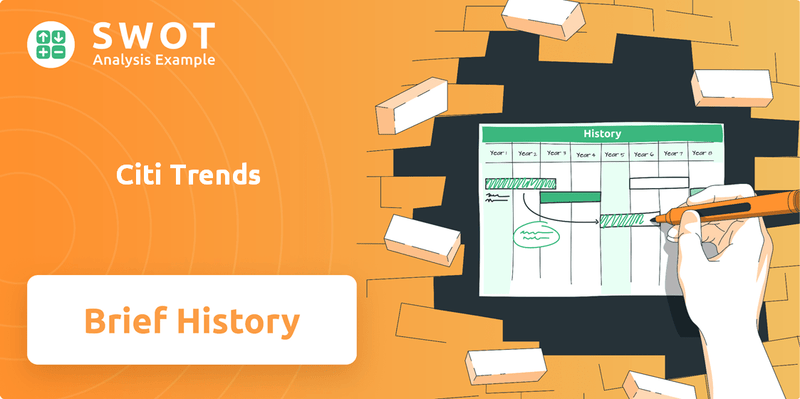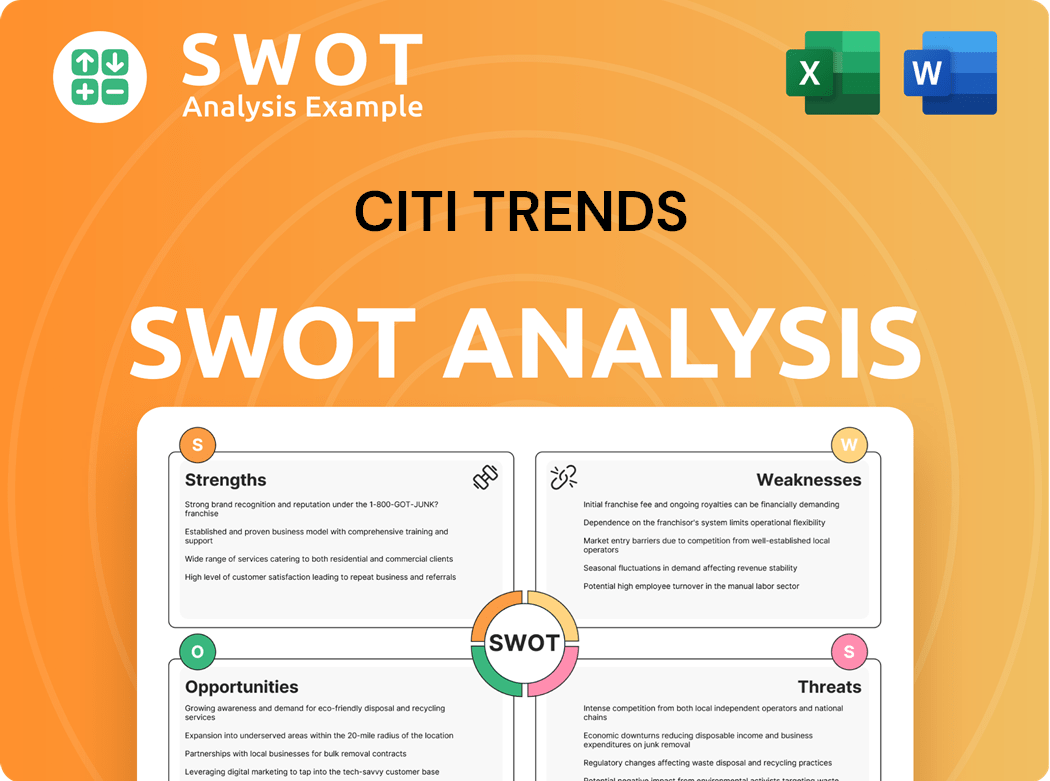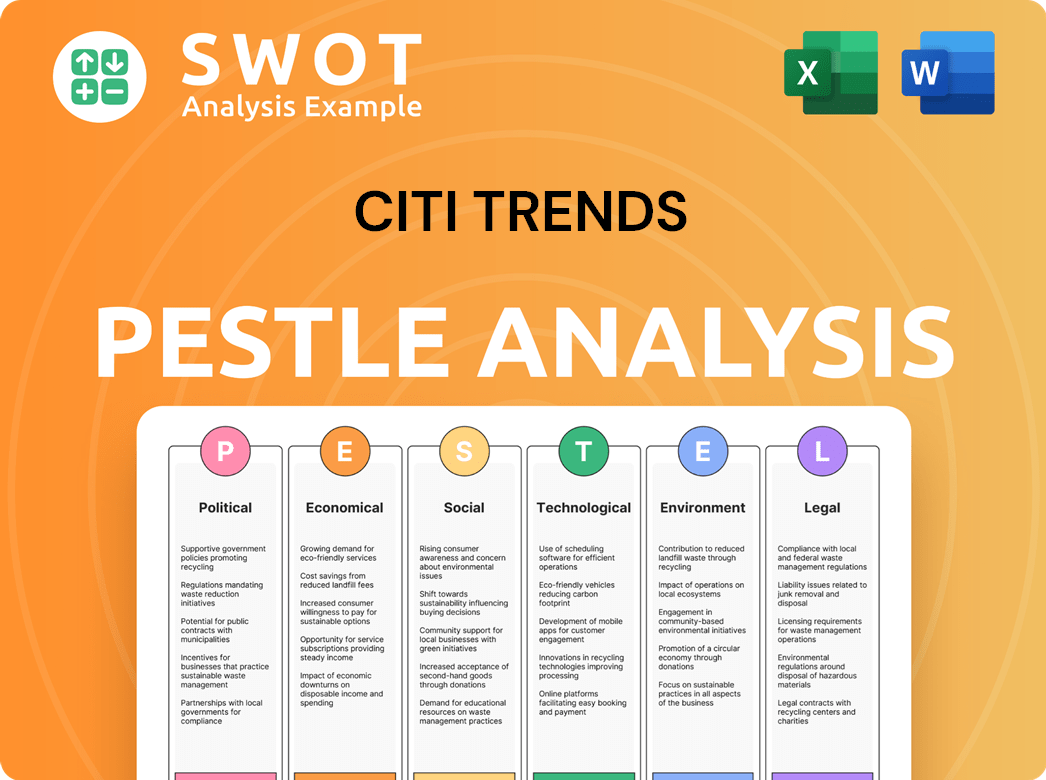Citi Trends Bundle
What's the Story Behind Citi Trends?
Citi Trends, a well-known discount retailer, has a rich history in the urban fashion and home goods market. Its journey began in 1946, evolving from Allied Department Stores into the Citi Trends we recognize today. The company's initial goal was to offer affordable fashion to budget-conscious consumers, especially in urban areas.

From its roots, Citi Trends has become a publicly traded Citi Trends SWOT Analysis company with a significant retail presence. With over 600 stores across the U.S. as of early 2024, the Citi Trends company continues to expand, solidifying its position as a key player in the discount retail landscape. This exploration into the brief Citi Trends history will uncover the key decisions that have shaped this fashion retailer into what it is today.
What is the Citi Trends Founding Story?
The Citi Trends story begins in 1946 with the establishment of Allied Department Stores. This marked the inception of a retail venture designed to serve a broad customer base, focusing on general merchandise. The company's origins are rooted in the post-World War II economic landscape, which fueled the growth of retail businesses.
The early business model of Allied Department Stores centered on offering a variety of goods at accessible price points. This approach laid the groundwork for the value-oriented strategy that would later define Citi Trends. The evolution into the Citi Trends we know today involved a strategic pivot toward urban fashion and home décor.
This transformation was driven by a clear opportunity to cater to budget-conscious consumers in urban and underserved communities. This strategic shift allowed the company to carve out a niche in a competitive retail environment. The name 'Citi Trends' reflects this focus on contemporary urban styles and affordability. For a deeper understanding of the competitive landscape, you can explore the competitive analysis of Citi Trends.
Understanding the foundational elements of Citi Trends provides context for its current market position and future prospects.
- Founded in 1946 as Allied Department Stores.
- Initial focus on general merchandise at accessible prices.
- Strategic shift to urban fashion and home décor.
- Targeted demographic: budget-conscious consumers in urban areas.
Citi Trends SWOT Analysis
- Complete SWOT Breakdown
- Fully Customizable
- Editable in Excel & Word
- Professional Formatting
- Investor-Ready Format

What Drove the Early Growth of Citi Trends?
The Citi Trends company's early growth and expansion followed its transformation from Allied Department Stores in 1946. This shift focused on its value-priced urban fashion and home décor model, enabling targeted growth. The initial expansion involved a gradual increase in store count, mainly in the Southern and Eastern United States. This strategy targeted urban and underserved communities.
Key developments included refining the merchandise mix. This involved emphasizing both branded and private label products. The goal was to offer compelling value to customers. This approach helped to establish the company within the competitive discount retailer market.
As of 2024, Citi Trends operates over 600 stores across 33 states. This expansion has been largely organic. The company identified new markets aligning with its target customer base. The focus has been on optimizing its supply chain and inventory management.
Maintaining its value proposition is crucial. This is a key element in its competitive landscape. Leadership transitions over the years have likely played a role. The company adapted to market demands and consumer preferences. Consistently delivering affordable trends has driven ongoing success.
The ability to consistently deliver affordable trends has been a key driver of its ongoing success and expansion. This focus has allowed the retail company to cater to its target audience effectively. This strategy has helped the company to grow and maintain its position in the fashion retailer sector.
Citi Trends PESTLE Analysis
- Covers All 6 PESTLE Categories
- No Research Needed – Save Hours of Work
- Built by Experts, Trusted by Consultants
- Instant Download, Ready to Use
- 100% Editable, Fully Customizable

What are the key Milestones in Citi Trends history?
The Citi Trends company has experienced several key milestones throughout its history, establishing itself as a significant player in the value-priced retail sector. A pivotal moment was its shift from Allied Department Stores to Citi Trends, signaling a strategic focus on urban fashion and home décor. This repositioning allowed the company to better serve a specific market segment and differentiate itself from competitors in the retail company landscape.
| Year | Milestone |
|---|---|
| 1986 | The company was founded, initially operating as Allied Department Stores. |
| 1999 | The company rebranded as Citi Trends, focusing on value-priced apparel and home goods for urban communities. |
| 2005 | Citi Trends went public, marking a significant step in its growth and expansion strategy. |
| 2010s | Citi Trends expanded its store footprint and enhanced its product offerings, including plus-size apparel. |
| 2020-2024 | The company adapted to changing consumer behaviors, investing in its online presence and supply chain resilience. |
Innovations at Citi Trends revolve around providing current fashion trends and home goods at accessible prices. This value proposition is a core innovation in its operational model, effectively democratizing style for budget-conscious consumers. The company continuously adjusts its merchandise to meet evolving fashion trends.
Citi Trends consistently offers merchandise at discounted prices, making fashion and home goods accessible to a broad customer base. This approach is central to its business model, attracting value-seeking consumers. This strategy has helped the discount retailer maintain its competitive edge.
The company focuses on curating merchandise that aligns with the fashion preferences of its target demographic, which includes urban and value-conscious consumers. This targeted approach ensures that the product offerings remain relevant and appealing. This strategy helps Citi Trends remain a relevant fashion retailer.
Citi Trends designs its stores to create an engaging shopping experience, often with a focus on visual merchandising and easy navigation. The store layouts are designed to encourage browsing and impulse purchases. This helps to drive sales and enhance customer satisfaction.
Citi Trends has focused on efficient supply chain management to ensure that it can quickly adapt to changing trends and maintain low prices. This includes strong relationships with vendors and efficient inventory management. This efficiency helps the company manage its costs effectively.
The company has invested in its digital platforms and online shopping capabilities to reach a wider audience. This includes an e-commerce website and social media engagement. This allows Citi Trends to compete effectively in the digital retail landscape.
Citi Trends has introduced customer loyalty programs to encourage repeat business and build stronger customer relationships. These programs often include exclusive discounts and promotions. This helps to foster customer loyalty and drive sales.
Citi Trends has faced challenges common in the retail sector, including economic fluctuations and intense competition. Maintaining a fresh merchandise assortment while adhering to its value pricing strategy requires agile inventory management. The company has adapted by strategically merchandising its stores and focusing on customer loyalty to counter these challenges. Supply chain disruptions and changing consumer spending habits also present ongoing challenges.
Economic downturns can significantly impact consumer spending, affecting sales and profitability. Citi Trends, as a discount retailer, is somewhat insulated, but still faces challenges during economic uncertainty. The company must manage inventory and expenses carefully during these times.
The retail industry is highly competitive, with both traditional and online retailers vying for market share. Citi Trends competes with other discount retailers, fast-fashion brands, and e-commerce platforms. Differentiating its offerings and maintaining a strong value proposition is crucial.
Disruptions in the global supply chain can affect the availability and cost of merchandise, impacting profitability. The company must navigate these challenges by diversifying its sourcing and optimizing its inventory management. This is a crucial part of the Citi Trends company background.
Consumer preferences evolve rapidly, requiring retailers to adapt their product offerings and marketing strategies. Citi Trends must stay ahead of fashion trends and consumer demands to remain relevant. This includes understanding the Citi Trends target audience.
Efficient inventory management is essential to balance supply and demand, minimize markdowns, and maximize profitability. The company must carefully manage its inventory levels to avoid overstocking or stockouts. This is critical for the Citi Trends business model.
Building and maintaining a successful e-commerce platform requires significant investment and expertise. Citi Trends faces challenges in driving online sales, managing shipping costs, and competing with established online retailers. This is a key part of the Citi Trends company timeline.
Citi Trends Business Model Canvas
- Complete 9-Block Business Model Canvas
- Effortlessly Communicate Your Business Strategy
- Investor-Ready BMC Format
- 100% Editable and Customizable
- Clear and Structured Layout

What is the Timeline of Key Events for Citi Trends?
The Citi Trends history is a story of strategic adaptation and expansion within the retail sector. From its origins in 1946 as Allied Department Stores to its evolution into the modern fashion and home décor retailer, Citi Trends has consistently focused on value and affordability. The company's journey includes pivotal moments such as becoming a publicly traded company in 2005 and navigating the challenges of the 2020 pandemic. The Citi Trends company has demonstrated resilience and growth, expanding its store footprint and adapting to consumer preferences.
| Year | Key Event |
|---|---|
| 1946 | Founding of Allied Department Stores, the precursor to Citi Trends. |
| Early 2000s | Strategic transformation into Citi Trends, focusing on urban fashion and home décor. |
| 2005 | Citi Trends becomes a publicly traded company. |
| 2010s | Continued expansion of store footprint across the Southern and Eastern United States. |
| 2020 | Navigates the challenges of the global pandemic, adapting operations and supply chains. |
| 2023 | Reports net sales of $782.9 million for fiscal year 2023. |
| 2024 | Operates over 600 stores in 33 states, maintaining a strong retail presence. |
| 2024 | Announces first-quarter 2024 net sales of $197.0 million. |
| 2024 | Completes a $30 million share repurchase program. |
| 2025 | Continues to focus on optimizing store performance and enhancing customer experience. |
Citi Trends is focused on optimizing its store portfolio. This involves potential new store openings in underserved markets. The company will also optimize existing locations to improve performance and customer satisfaction. This strategic approach aims to enhance market presence and profitability.
Enhancing the in-store customer experience is a key priority for Citi Trends. This includes improvements in merchandise presentation. The company is also focused on providing efficient service to customers. These efforts are designed to create a more engaging and satisfying shopping environment.
Citi Trends is looking at continued integration of digital strategies to support its physical stores. This includes improving online product visibility. Localized marketing will also be used to drive sales. These digital initiatives complement the brick-and-mortar presence.
The company is positioned to benefit from industry trends. The increasing demand for value-oriented retail will positively impact Citi Trends. Leadership is committed to driving shareholder value. This will be achieved through operational excellence and strategic growth.
Citi Trends Porter's Five Forces Analysis
- Covers All 5 Competitive Forces in Detail
- Structured for Consultants, Students, and Founders
- 100% Editable in Microsoft Word & Excel
- Instant Digital Download – Use Immediately
- Compatible with Mac & PC – Fully Unlocked

Related Blogs
- What is Competitive Landscape of Citi Trends Company?
- What is Growth Strategy and Future Prospects of Citi Trends Company?
- How Does Citi Trends Company Work?
- What is Sales and Marketing Strategy of Citi Trends Company?
- What is Brief History of Citi Trends Company?
- Who Owns Citi Trends Company?
- What is Customer Demographics and Target Market of Citi Trends Company?
Disclaimer
All information, articles, and product details provided on this website are for general informational and educational purposes only. We do not claim any ownership over, nor do we intend to infringe upon, any trademarks, copyrights, logos, brand names, or other intellectual property mentioned or depicted on this site. Such intellectual property remains the property of its respective owners, and any references here are made solely for identification or informational purposes, without implying any affiliation, endorsement, or partnership.
We make no representations or warranties, express or implied, regarding the accuracy, completeness, or suitability of any content or products presented. Nothing on this website should be construed as legal, tax, investment, financial, medical, or other professional advice. In addition, no part of this site—including articles or product references—constitutes a solicitation, recommendation, endorsement, advertisement, or offer to buy or sell any securities, franchises, or other financial instruments, particularly in jurisdictions where such activity would be unlawful.
All content is of a general nature and may not address the specific circumstances of any individual or entity. It is not a substitute for professional advice or services. Any actions you take based on the information provided here are strictly at your own risk. You accept full responsibility for any decisions or outcomes arising from your use of this website and agree to release us from any liability in connection with your use of, or reliance upon, the content or products found herein.